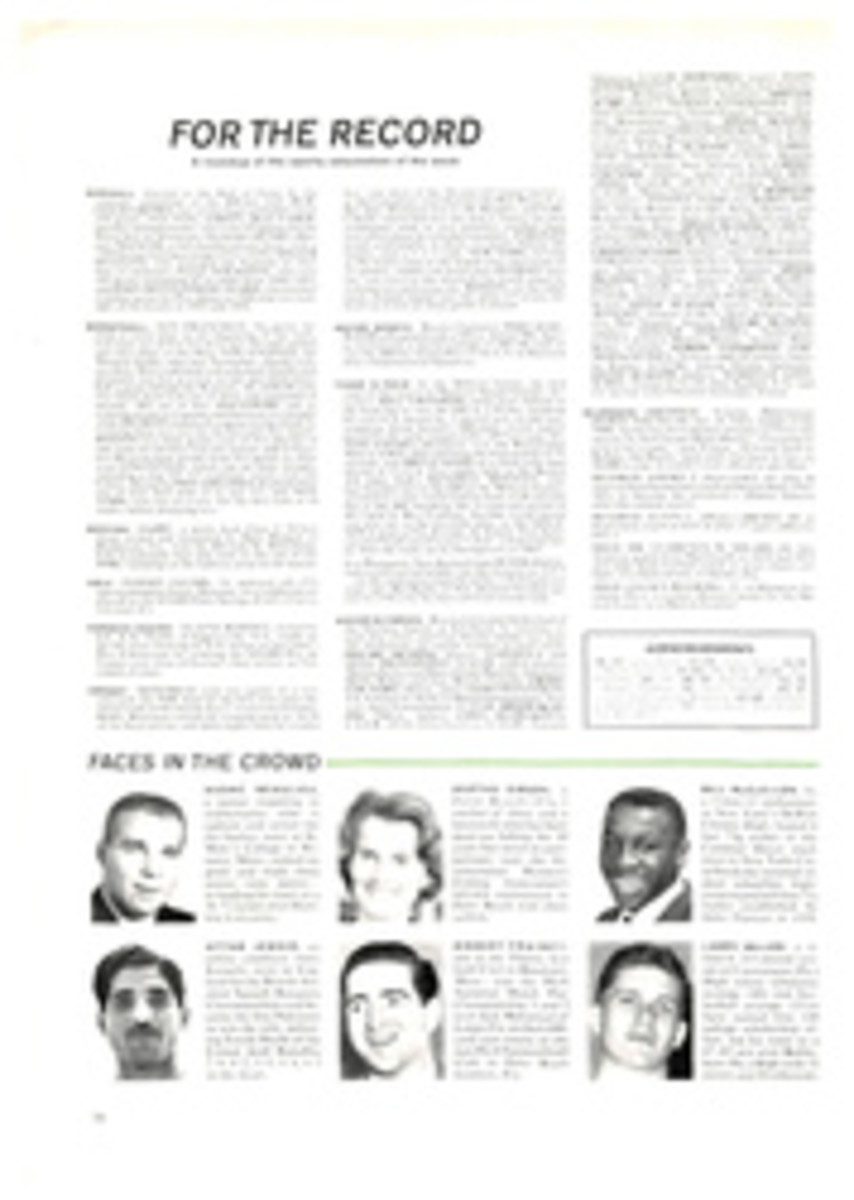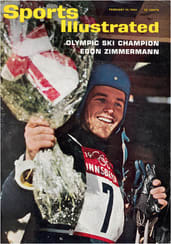
Young druggist's sure Rx
The best half-miler in the world right now is a tall, bony Canadian named Bill Crothers, who wears glasses strapped to his head when he runs and who looks less like the best half-miler in the world than he does the man behind the counter of the corner drugstore. It is somehow comforting to realize that Crothers, a 23-year-old graduate of the University of Toronto, is indeed a pharmacist. He works in a drugstore in Markham, a suburb of Toronto. He fills prescriptions all day and after work drives several miles downtown to the university, where he spends a couple of hours each evening working out with fellow members of the East York Track Club.
The East York Track Club is a name that few people outside East York (another suburb of Toronto) ever heard much of until the last few years. Then a crack relay team, the youthful distance runner Bruce Kidd and Crothers began winning races with such consistency and in such fast times that "East York" became synonymous in track circles with "awfully good." Kidd created the biggest sensation in indoor track history in 1961 when, at the age of 17, he came from nowhere (Toronto readers will forgive this inelegant reference to their metropolis) to beat men five and ten years his senior at two and three miles. Kidd is 20 now and in his fourth season of big-time track. He has taken U.S. national championships at three and six miles home to Canada for safekeeping, and the U.S. cross-country championship, too.
But, though Kidd is more famous, Crothers has become East York's best performer. Kidd has gone through a year or so of mental uncertainty, as far as his running is concerned, and has only just begun to regain his old toughness and confidence. He won the three-mile run decisively at the Millrose Games last week, trailing the lead runner until the last quarter mile and then sprinting strongly to win, but until that last long drive it sometimes seemed that Bruce might quit on himself.
Crothers, on the other hand, appears never to have any doubts about his ability. At the Millrose Games, for example, he was in a harder race, one that turned out to be the fastest competitive half mile ever run indoors in America, and he had to cope with one of the best middle-distance runners in the world in Noel Carroll of Ireland. Yet he completely dominated the race. He stayed comfortably off the extremely fast pace set by Charley Buchta, who eventually finished third, but when Carroll jumped past him and took the lead away from Buchta, Crothers moved instantly, powered past the sprinting Irishman a lap from home in a sterling display of speed and strength and easily held his lead to the finish. He even used a bit of indoor-track gamesmanship, moving wide on the last turn to tempt Carroll into trying to pass him on the inside and then closing that gate as soon as Noel took the bait. Despite the record time (1:50 flat), Crothers was easing up as he approached the tape and afterwards looked about as exhausted as a druggist who has just sold a bottle of aspirin.
The ascendancy of Canadian track and field (Crothers, Kidd, Sprinter Harry Jerome and Shot-putter Dave Steen are all likely Olympic medalists, and so are a couple of girls) is especially remarkable when it is realized that there has been little intensified effort to develop and improve it. Schools and colleges do not play the important role in Canadian sport that their counterparts do in the U.S. Clubs—-and not very prepossessing ones at that—are the backbone of track and field. It is with these organizations that collegiate runners get most of their competition. Crothers, for instance, was a member of the track team at the University of Toronto, but simultaneously he was a member of the East York team, and it has been for East York that he has run his important races.
And what is the East York club? It is simply a collection of runners who want to run. (There are no field-event men in the club.) They have no building or permanent headquarters. They work out at a high school field in East York or at the University of Toronto. Members pay $10 a year dues, from Crothers to the slowest distance man, and anyone who wants to can join. "Some clubs go after out standing high school runners," Crothers says, "but we're not a recruiting club. Though, of course, good runners want to join us now, like Chris Williamson. Chris attends the University of New Brunswick, but he comes to Toronto in the summer to work so that he can run with us."
The runners elect their own officers. Crothers is currently president, and under him are vice-presidents in charge of obtaining uniforms, taking care of entries, collecting dues, keeping records of members'performances on the track, and so on. Fred Foot, who coaches the University of Toronto team, is the East York coach, too. Both jobs are avocations. Foot earns about $100 a year as the university's coach and nothing at all for coaching East York. In the U.S. a man can earn a comfortable living coaching track and field. In Canada he can gain a good deal of fun and satisfaction, but for bread he had better have a paying job, too. Foot is an accountant with the Metropolitan Toronto Police Department, and he works a full day. Last week, for instance, he left work late Thursday afternoon, flew to New York and got to Madison Square Garden for the Millrose Games after 8 o'clock in the evening, watched Crothers and Kidd win their races, caught a few hours' sleep, took a 7 a.m. flight back to Toronto and put in a day's work again on Friday.
Crothers' approach to running has the same casual, refreshingly amateur air. A few weeks ago he had to cancel out of the Los Angeles Invitational meet because he injured a knee playing ice hockey. American coaches and athletes were aghast at the idea of a runner of Crothers' class playing a game as rough and dangerous as hockey. Reports dripped down to the States from Canada that Crothers was a fanatic about the ice game and that this predilection had upset his coach no end.
"Oh, that's all out of proportion," Crothers said the other day. "I'm not a nut about hockey. I like it, but it's like baseball. Every boy in Canada grows up playing hockey. I was at a friend's house one Sunday afternoon, and a few of us went out on the ice and played a little game. That's all. You can't help falling down a few times. I hit my knee—I wasn't wearing knee pads—and it swelled a bit. A day or so later it was so stiff I could hardly walk on it. Fred thought I better scratch from the Los Angeles meet. It was nothing serious. It cleared up in a few days."
If this casual, amateur, pleasantly tough attitude appalls those American coaches who like to supervise every detail of an athlete's career, let them remember that most American runners who have seen New Zealand's Peter Snell in action think he is unbeatable, whereas Crothers, who has run against Snell three times at various distances, is convinced otherwise. "I can beat him," says this part-time hockey player in a quiet un-Cassius Claylike way. "I can beat him at 800 meters because I am faster than he is. I can stay with him and outsprint him. I know I can."
PHOTO
CROTHERS' STRIDE IS DRIVING AND FORCEFUL

